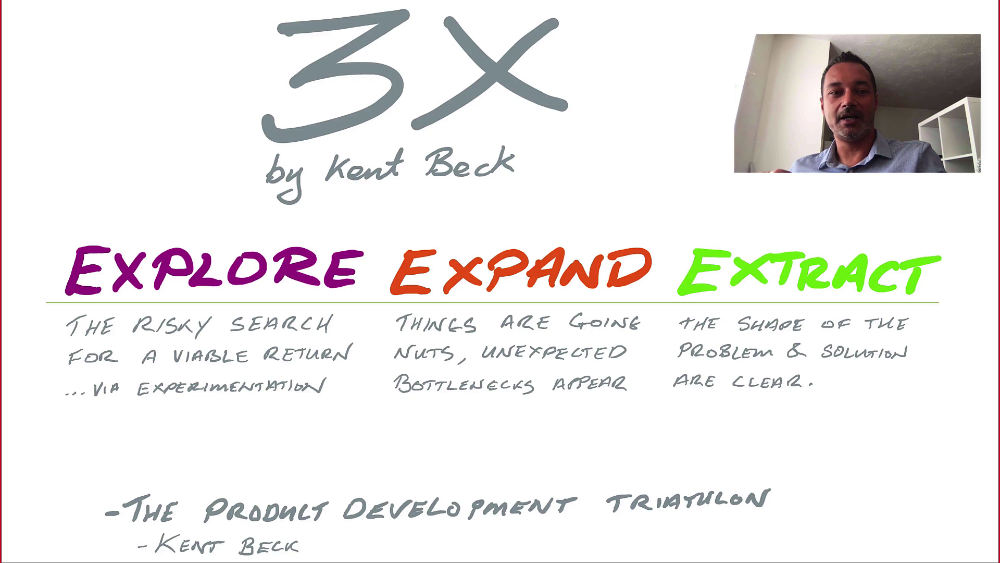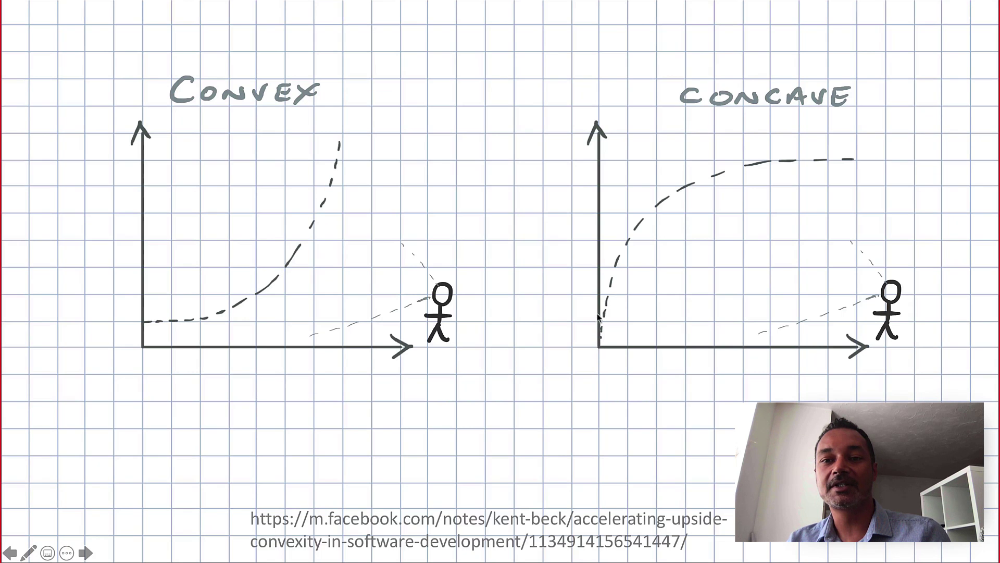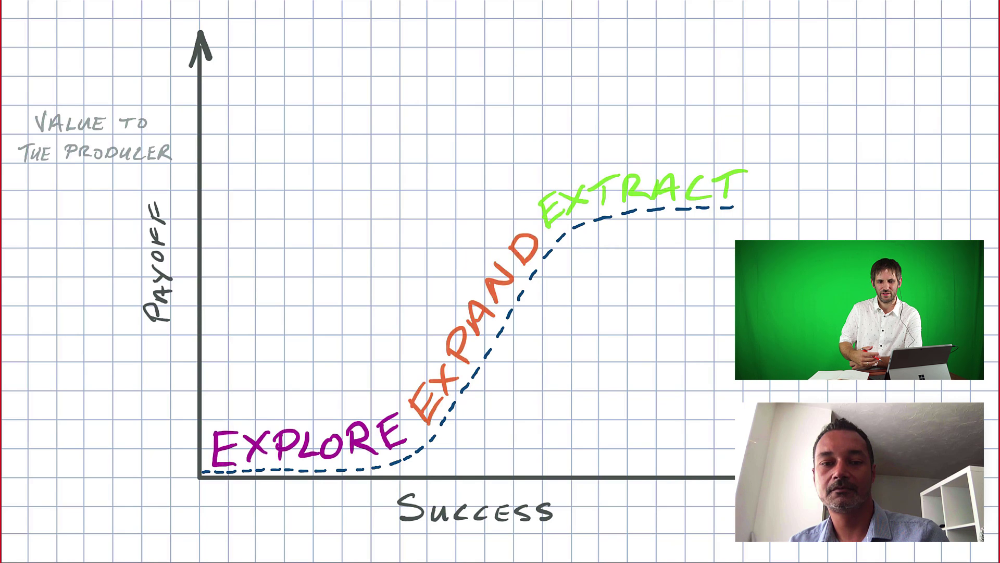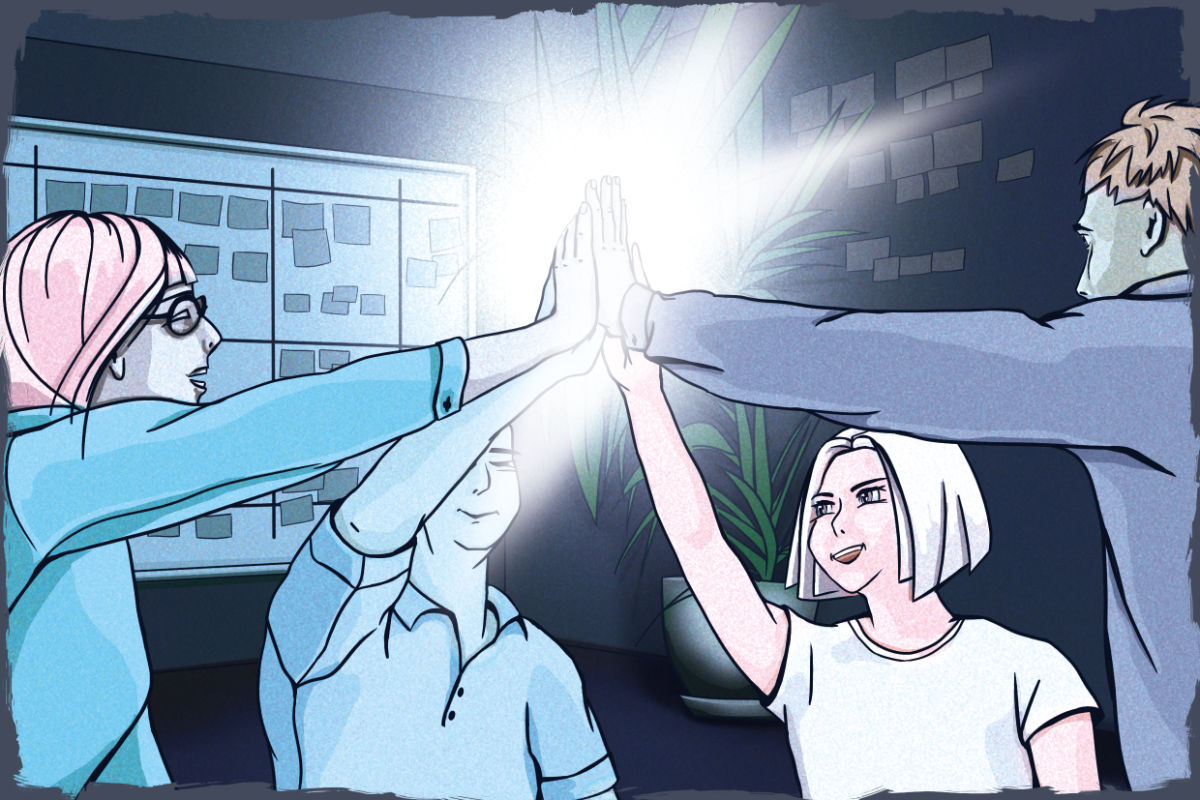I spoke about “3X thinking” with Antony Marcano. 3X was originally coined by Kent Beck and it describes the “profile of a winning idea”. 3X thinking will help you to determine whether it’s best to experiment, scale or operate for any given idea.
In this first video, Antony and I talk about the basics: What is 3X thinking and how can it help you as a developer, manager or C-level executive?
Read the whole transcript below the video.
3X - An Idea from Kent Beck
David: Hi, I’m here with Antony Marcano, and we’ll talk about eXplore, eXpand, eXtract, or 3X thinking. Hello Antony!
Antony: Hello David, how are you?
David: Fine, thanks! Any you?
Antony: Really good, really good! Just happy to be here talking to you about this idea!
David: Yea, thanks for being here and it’s great that you found the time. Let’s talk about the basics first… What was hard for me to learn when I first tried to wrap my head around the concept of 3X was that you need a lot of background knowledge.
But before we come to that… I think it’s basically a thinking tool that allows us to think about the payoff of a feature or idea or product in terms of it’s success. Maybe you can talk about this a little bit first.
Antony: Yea, I think the first thing is really to give credit where credit is due. 3X is obviously not my idea, it’s the idea of Kent Beck. And I just discovered recently that not everybody knows who Kent Beck is.
So, for those who don’t know - He was one of the co-creators of eXtreme Programming (XP) and he tought XP which contains many of the practices that we take for granted today on agile teams, everything from user stories to test-driven development, continuous integration and other such things, came from XP in the late 90s.
And since then, he worked on various things and one of the places he went to was Facebook. And he noticed that Facebook worked a little bit differently form other companies. And as a result, certain things started to make more sense to him.
And that culminated into him expressing these ideas in terms of 3X, which is the idea he came to.
I could probably share my screen briefly.
Phases in the Journey of an Idea
David: Yea, I think the idea was that in different phases of an idea or feature you need different ways of approaching it or of developing it further, right?
Antony: Yes, so one of the favourit pieces that I read that he wrote was the product development triathlon and he talked about this… it’ kind of a series of things that happen, like in a triathlon, where there’s running, cycling and swimming - not necessarily in that order - there’s three very different sets of rules going on, three very different sets of strengths and skills involved in each part of the process.
And it’s - he kind of used this as a metaphor to get the point across that often we need a completely different mindset and a completely different approach, set of practices, culture for these three very different stages of what I call “the profile of a winning idea”.
And it can be any idea, at any level. But for the purposes of this, let’s just stick with the product development level of it all.

So, the idea is that when you are exploring, that’s the point at which you’re kind of doing a somewhat risky search for a viable return. So, this is where you might experiment with an idea, you take a feature idea, you try lots of different feature ideas to find one that’ll resonate with your customer base.
And suddenly everyone wants that feature and then that may result in us having to throw infrastructure at it to cope with the load. And the demand may require that we throw manual processes at it to cope - things that are quite expenses just to survive the period of expansion.
And the third stage is “extract”. Now the shape of the problem and solution are clear and now it’s much more about lowering the operational costs and extracting as much value as we can from that as possible.
It was the guy on the right’s idea, that’s Kent Beck. That was in his last few days at Facebook. And something he said to me was… 3X is a “can’t unsee concept”. Once you see it, you see it everywhere. And honestly I really did start to see it everywhere.
So, where it came from for him was the idea of… It started with this podcast that he was listening to. And they were talking about convex investments and concave investments.

The idea being that some investments have an exponential return like this. It takes time for them to mature, but then, when they do, they mature big. And there are other investments that mature very rapidly from a given point in time, but then they’ll level off.
And what he realized is that these two things actually fit together.
It’s a Distribution
David: Yeah, but the interesting thing is that the x-axis here is not necessarily time, but that those ideas are linked to success. So, payoff over success, not neccessarily over time.
Although success might me related to time…

Antony: It might be related to time, indeed. And that’s the thing that he came to realize with the - you know, the x-axis is success, and the y-axis is payoff. So, it’s kind of a distribution rather than a time line, in that while an idea is very successful, and that to him means there is some measure that it is valuable to your customer, and that there comes a point at which you start to realize how that value to your customer can be a value to you. And therefore bring about payoff.
So, when you have a growing success and growing payoff, you’ve got something that’s proven now. And at this point, you’re more likely to experience both to be struggling to survive demand externally from your customers for that feature and a willingness to invest in it because it’s generating a payoff as well.
And as the payoff levels out, it’s still getting more and more successful, but the payoff levels out, that’s when you’really looking at extracting. And then, again because it’s not a time line, success is not infinite, it might stop here, at this point here. In which case both the growth in success and payoff essentially stops.
However, continuing to operate that product or that feature may be expensive because of the choices you made whilst trying to survive during this rapid expansion of the idea. And now it’s really about trying to find ways of making it cheaper to run, move it onto cheaper infrastructure, keep people interested by adding some new features, …
But now you’ve got a lot more to lose, so the way you would go about that would be in an as low as risk way as possible.
And what he says is that he came to realize that it’s extract-type problems that people who are using more waterfall-oriented processes were hoping to solve. Not necesserily that it solves it, and not necessarily that it solves it in a very good way. But the intent behind the thinking of many sort-of waterfal-based ways of working was trying to solve that problem.
David: Yea, it’s also like in mass production or in how you operate factories. You have something that already works, and you have a proven payoff, and now you want to earn more by lowering your costs, right?
Antony: Yes, so that kind of factory-menality kind-of almost makes sense where something gets to the point where it’s just a standard, stable thing. You’ve got a pretty straight-forward process of how to make changes to it. And then you invest in things to make it cheaper.
And I’ve got a couple examples about that.
And what he says is that XP and other agile methods are somewhere areound explore and expand. Aspects of XP help with explore, but not necessarily all of them. Aspects of XP can help with expand and aspects of XP can help with extract.
But on it’s own may not necessarily work that well in the way that he originally envisioned it, in the extract space.
David: Like, because “agile” is a lot about doing expreiments and failing quickly so that you can learn quickly and change direction if needed. This sounds more like better fitted to explore where you try many things than to extract where basically you already did all the experiments before…
The Profile of a Winning Idey
Antony: Well, yes an no, because still an element of it is, you know, I think XP somewhat operates in the extract space where you may have an existing product. It’s still valuable to experiment with feature ideas, for example.
For example, you may have a couple of micro services running on one technology that costs you a lot of money in license fees and infrastructure. And you may find that if you re-wrote these services in a different language that’s maybe open source, that runs on cheaper cloud-based infrastructure, at that point it might also be worth applying it there, because we’re always learning.
And I think this is one of the common misconceptions about… Waterfall was really addressing a problem from the 1960 when hardware was really expensive. So, you couldn’t iterate in the computer, it was too expensive to do that.
So, you had to iterate on the cheapest medium available, which at the time was paper. But now, computers are ridiculously cheap. So, we’re able to iterate in the computer.
And in fact what we’re essentially seeing is that because this particular model is the “profile of a winning idea” - Because it could be any idea. That idea could be “I’ve got this idea about how we could lower the infrastructure cost”. You’d still want to explore by experimenting with that idea to see if it actually makes sense. If it then did make sense, you’d have demand for people wanting you to roll that out as far and wide as possible because it’s saving you money, and once it’s rolled out then ongoing support and maintanance of it, you want that to become as inexpensive as possible.
Fractal Nature - Turtles all the Way Down
So, interestingly, this particular curve seems to apply at a fractal level. So, it can be at the product level, the infrastructure level, the feature level, even all the way down to “What variable name should it use for this? Let’s try this one… No, no, let’s try this one.. Oh, now we’ve got a new metaphor that we can apply across this entire part of the code base!”. This is the thing.
David: I wanted to say that, when you gave the example with the micro services, I mean the product might be in the extract phase, but switching to a different micro-services-stack might start a whole new curve like that - inside the extract phase, right?
That’s what you’ve been talking a lot about - The fractal nature of 3X.
Antony: Yea, I’d like to take credit for it, but that was another Kent Beck realization, so I’m standing on the shoulder of a giant here.
David: Yeah, of course.
Antony: I’ve struggled with how to represent that, but I think we’ll come back to this later.
David: Yeah, I just wanted to say before we get more into the more advanced stuff like the fractal nature, maybe we should talk about what does it mean to me, as a developer or product manager or CTO or…
How can I learn from it or incorporate it into my thinking?
Antony: Well, first and foremost, I think it would take some time, I think… and a bit of reading and a bit of thinking about what it means. Because it’s hard to get the whole idea across here.
What we’ve talked about so far is really just scratching the surface a bit. So, before trying to use it or to apply it in any way, it’s definitely worth doing more reading about it.
There’s also plenty of online resources in terms of talks from Kent where he tries to explain it in numerous different ways, and some talks from me also, where I’ve been trying to explain it as well.
So, first to understand it.
David: Then I’m going to link those resources in the description of this video and let’s talk more about learning it and applying it in practice in our next video.
What’s the Benefit? Rules of the Game
Antony: But it’s probably worth saying: What’s the benefit of it?
I think for anyone - whether it’s a CEO, a middle manager, product manager, an engineering team - the benefit that it gives you is that it helps you recognize when the rules of the game have changed.
And it helps you recognize when you need to change how you’re playing the game.
Because when you’re exploring an idea, the speed of experimentation is key. And then it helps you recognize that, well, what I should be doing now is trying to find a way of experimenting with as many different ideas as possible, as quickly as possible - and safely, in order to find out what one of those ideas matters the most to my customers.
And then you can continue to explore to find what the payoff is for you.
But then, if you keep experimenting, experimenting, experimenting, and one of your ideas is taking off, and you haven’t recognized that it has now left the explore phase and transitioned into the expand phase, and you’re still playing by explore rules, your idea won’t win. It won’t survive.
Because you won’t be trying to support it and enable the ongoing expansion.

Similarily, while you’re expanding, and then it transitions to an extract phase, and you’re still trying to expand, then you’ll be playing by the wrong, by different set of rules than the game itself, than the game that you’re playing.
And then recognize when you’re in extract. And actually the moment when I see it more than anything else, is many large organizations are playing explore games with extract rules.
So, they’re trying to minimize risk and develop ideas in ways that really are very applicable if you’ve already got well-established concepts or products and you’re really just responding to feature requests at this point. There’s nothing particularily innovative happening at that time.
Then, when you experiment a new… Essentially trying to keep costs down and so, when actually, at this point you should just be experimenting and expecting most of your ideas to go into the bin, and not having someone put together a 50-page business case to justify how much of a return this thing that you haven’t even tried yet is gonna give.
Instead, just create enough space for people to experiment, experiment, experiment.
So, I think it’s about understanding where your idea is, whether that’s a product or a feature, in it’s journey and not trying to play explore games with extract rules.
That’s one of the starting points of where it becomes beneficial.
To Recap…
David: Let me quickly recap to see if I understood everything correctly. We talked about how payoff of an idea or product is linked to it’s success, and this link is highly unlinear. So, it’s an S-Curve.
You cannot have any payoff when you don’t have success, and then the payoff doesn’t immediately rise with success. But when it rises, it does so big. Then it reaches a point where it can’t rise any further and then you’re in a different phase.
Antony: Yea, exactly. So, I think the key for me is… If you haven’t found how this idea is a payoff for you, the producer, not the consumer of the idea, then you’re probably still exploring.
But once it’s clear there is a payoff for your idea and that payoff starts becoming a reality, then that’s where you’ll see this where you’ll find that you’re in the expand phase.
David: And the interesting thing here is that you should probably play by different rules or apply different techniques - different management techniques or different techniques for working together - when you’re in the explore phase than when you’re in the expand phase than when you’re in the extract phase. Right?
Antony: Yes!
David: OK, and then the big benefit of this thinking for teams, middle managers and even C-level executives would be to have a thinking tool that helps you recognize when the rules of the game should change. Because you now move from explore to expand or from expand to extract.
Antony: Well, it’s not even recognizing when they should change, but when they have changed, but you’re still playing by the old rules. And that’s the trick because, you know, you may not have a choice as to as to whether it transitioned.
In fact, if it’s a successful enough idea, and it’s a public-facing idea, the rate at which demand for that idea can increase can be quite sudden and dramatic.
You know, it could take a long time to find out what that idea is, but when you find it, it can be very sudden and dramatic.
And a great story that I refer back to sometimes for that is “Angry Birds”. Now, “Angry Birds” was, I think, roughly the 28th game the developers created. The previous ones weren’t particularily a success. And each one of those was essentially an experiment.
But somehow all of the learnings from that, not all of which they can exactly explain how it came together, became “Angry Birds”. And suddenly, everyone wanted to get “Angry Birds”.
And whilst it took many, many years to get to that point, to the outside world, they became an overnight success. And they did not have a choice anymore, because everyone wanted to get “Angry Birds”.
So, it’s about recognizing when that happened, and then changing how you play the game, based on this completely new set of rules.
David: OK, let’s talk more about 3X thinking in practice in the next video.
Just one more question: Where can people find you on the internet?
Antony: Yea, I’m pretty easy to find, if you just google my name: Antony Marcano, then it’s pretty easy to find me (Also check the links below…).
Find me by my full name on Twitter. And occationally I might look to LinkedIn or my website AntonyMarcano.com, or contact me via Riverglide, my consultancy.
David: OK, thanks, I’ll also put links to all those sites into the notes of this video. And I’ David Tanzer and I’m “dtanzer” on Twitter and on GitHub and basically everywhere.
Also, subscribe to this channel, so you don’t miss the next video, where we’ll talk more about “3X thinking in practice”.
Links
- The Product Development Triathlon
- Comparing Explore, Expand, and Extract: Topics in 3X
- Your Market Tells You To Expand: The Explore->Expand Transition in 3X
- Video: 3X with Kent Beck
- Kent Beck’s 3X — Explore, Expand, Extract
- Antony Marcano on Twitter
- AntonyMarcano.com
- Riverglide, Antony’s consultancy
Read / watch all parts of “#3Xthinking” here:

